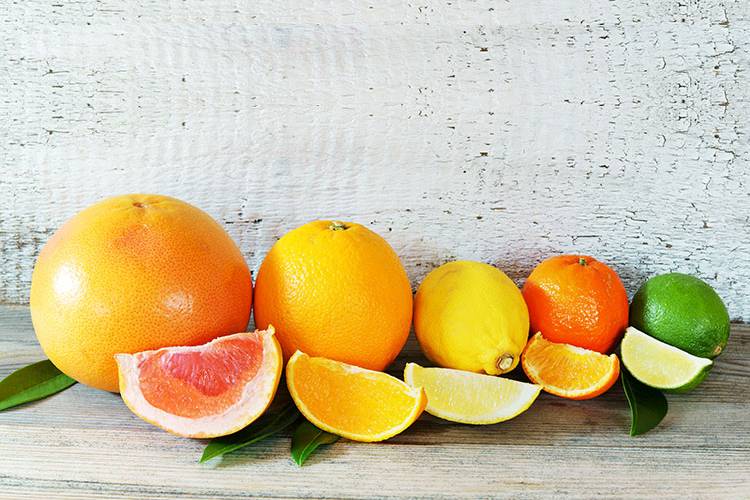Citrus fruits, a natural source of Vitamin C and anti-oxidants
Citrus fruits are famous for their high Vitamin C content and their acidic or sweet taste, depending on the variety we eat. Spain is one of the biggest producers of these fruits in the world. Thanks to our climate, we can eat these refreshing fruits practically all year round.
fresh food
Share

Spain, Top 5 in world production
Although the cultivation of citrus fruits is very widespread on a global scale, it seems that their origins lie in Southeast Asia. Today, barely 15 countries are responsible for 80% of their production. The main citrus fruit producers are China, Brazil, Mexico, the USA and Spain, followed by India, Turkey, Italy, Egypt, Argentina, Japan, Pakistan, Cyprus, Morocco and South Africa. In this country, the main areas where they are grown are the Valencian Community, Andalusia and Murcia.
It is not known exactly what the total of cultivated land dedicated to citrus production is throughout the world, but it is estimated that it could be more than 3 million hectares. The latest report from the FAO shows a total production of all types of citrus fruits (oranges, mandarins, lemons, limes and grapefruit) to be some 78 million tons, of which 66% are oranges, 16% mandarins, 11% lemons and limes and 7% are grapefruit.
For every month, there’s adifferent variety
Fortunately for us, the Mediterranean climate allows us to enjoy the citrus season practically the whole year round.
The main varieties to be found on the market are:
• Oranges: Washington Navel,Thomson, Newhall, Navel, Navel-Late, Valencia-Late and Salustian
• Mandarins: Marisol, Satsuma, Hernandine, Okitsu, Esbal, Ortanique, Fortune, Clemenville, Oroval, Clemenules, Elledale and Arrufatine.
• Lemons: Berna, Fino, Eureka, Lisbon;
• Grapefruit: Marsh, Red Blush, Star Ruby.
However, would you know how to distinguish the best variety of orange or mandarin at any given moment of the year? The following calendars can help you to find out more.
CALENDAR FOR MADARINS | |||||||||||
SEPT | OCT | NOV | DIC | ENE | FEB | MAR | ABR | MAY | JUN | JUL | |
| Marisol | |||||||||||
| Satsuma | |||||||||||
| Hernandina | |||||||||||
| Okitsu | |||||||||||
| Esbal | |||||||||||
| Ortanique | |||||||||||
| Fortuna | |||||||||||
| Clemenvilla | |||||||||||
| Oroval | |||||||||||
| Clemenules | |||||||||||
| Ellendale | |||||||||||
| Arrufatina | |||||||||||
CALENDARIO FOR ORANGES | |||||||||||
SEPT | OCT | NOV | DIC | ENE | FEB | MAR | ABR | MAY | JUN | JUL | |
| Navelina | |||||||||||
| Navel | |||||||||||
| Navel Late | |||||||||||
| Valencia Late | |||||||||||
| Salustiana | |||||||||||
Citrus fruits, natural antioxidants
Although our organism has its own antioxidants to defend against free radicals, these are not enough and that is why we have to obtain them from our diet.
Citrus fruits (oranges, tangerines, lemons and grapefruits) are foods containing ascorbic acid or vitamin C, capable of delaying cellular ageing. Due to its hydro-solubility, this antioxidant vitamin is found intra-and extra-cellularly in most biological systems. Its antioxidant role is twofold, according to the Spanish Nutrition Society (SEN): It removes radicals directly and protects lipoprotein LDL from oxidation, thus reducing the risk of atherosclerosis and cardiovascular disease. It also helps to regenerate vitamin E.
In addition, vitamin C is involved in the formation of collagen, bones and teeth, the red blood cells, absorption of iron from food and it also reinforces our immune system. Some citruses contain potassium, a mineral needed for normal muscle activity, and magnesium, which helps the proper functioning of the intestine, nerves and muscles. Their richness in sugars, especially in fructose, makes them easily absorbed by the body. They also have a high water content. Citrus fruits are low-calorie foods, and as their fat and protein content are low, they are an important ally in our daily diet, especially in winter.
Did you know that… -The typical orange colour of oranges and mandarins is due to their exposure to the cold at night while they are still on the tree, so in tropical countries ripe oranges are green. - Lemons have astringent effects. Totally banned in chronic constipation and gastroduodenal ulcers. - The fibre in the orange is found in the white pulp under the skin and between the segments. Therefore, the fibre content of juice is low, as this part is usually strained and discarded. - Oranges and lemons are the citrus fruits that contain the most vitamin C. |






